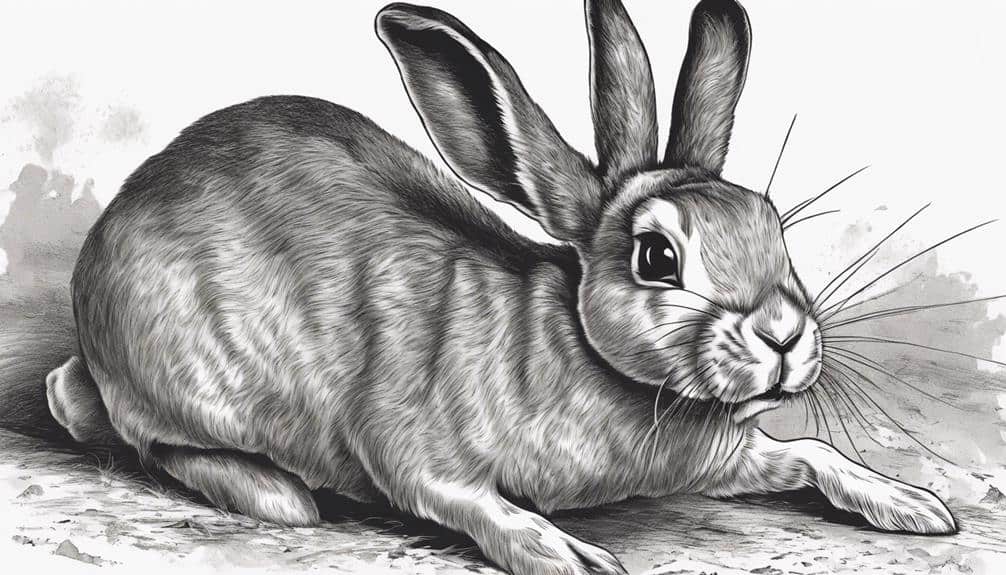Imagine a serene meadow bathed in the soft glow of twilight, where rabbits move stealthily, their ears perked, and noses twitching.
In this tranquil setting, the rhythmic thumping of a rabbit's foot against the ground breaks the silence, conveying a message that transcends words.
Have you ever wondered about the mysterious ways in which these creatures communicate through such subtle yet powerful gestures?
Unveiling the secrets behind rabbits' thumping behavior could offer a fascinating glimpse into their intricate world of nonverbal communication.
Contents
- 1 Key Takeaways
- 2 Signaling Danger and Alerting Others
- 3 Expressing Displeasure or Fear
- 4 Establishing Territory and Dominance
- 5 Seeking Attention or Interaction
- 6 Indicating Pain or Discomfort
- 7 Frequently Asked Questions
- 8 – What are the Different Ways Rabbits Communicate Other Than Thumping?
- 9 Conclusion
Key Takeaways
- Thumping alerts of danger and displeasure, signaling fear and anxiety.
- Establishes dominance and territorial boundaries through rhythmic thumping cues.
- Seeks attention and interaction by using thumping as a form of communication.
- Indicates pain or discomfort, helping to identify health issues in rabbits.
Signaling Danger and Alerting Others

When rabbits thump with their hind legs, they're signaling danger and alerting others to potential threats in their environment. This important aspect of a rabbit's survival instincts.
The rhythmic thumping creates vibrations that warn their family of impending danger, whether it's a predator lurking nearby or a disturbance in their surroundings. By combining thumping with alert body language, such as ears positioned forward, rabbits effectively communicate to their group the presence of a threat.
This behavior isn't limited to dangers above ground; rabbits also use thumping to signal potential threats below the surface. Their acute awareness and quick response demonstrate how they prioritize the safety of the group.
Remaining vigilant, rabbits are always ready to thump again if the danger persists, showcasing their dedication to protecting and serving others in their community.
Expressing Displeasure or Fear
To understand a rabbit's state of mind, pay close attention to their rhythmic thumping, as it serves as a clear indicator of expressing displeasure or fear. When a rabbit feels threatened or anxious, their body language, especially their legs, can reveal their emotional state through thumping.
Here are some key insights to help you recognize when a rabbit is expressing displeasure or fear:
- Thumping as a Warning Sign: Rabbits use thumping as a way to communicate potential danger to their surroundings, signaling that they aren't at ease.
- Repeated Thumping for Displeasure: When a rabbit is displeased, they may exhibit a more persistent and intense thumping behavior, emphasizing their discomfort.
- Signaling Anxiety: Thumping can also indicate when a rabbit is feeling anxious and in need of safety, prompting you to provide reassurance and a sense of security.
Understanding these subtle cues in a rabbit's behavior can help you respond appropriately to their emotional needs, ensuring a harmonious and stress-free environment for your furry friend.
Establishing Territory and Dominance

Rabbits assert their dominance and establish territorial boundaries through vigorous thumping with their hind legs. This behavior communicates a clear message to other rabbits about who holds the power and the boundaries of their living space.
The intensity of the thumping can vary, depending on the rabbit's need to mark its territory and assert dominance within the group's hierarchy. By utilizing thumping as a means to mark territory, rabbits effectively prevent conflicts and maintain order within their social structure.
Through this distinctive form of communication, rabbits express their presence and set clear boundaries to avoid potential disputes. Observing a rabbit's body language, particularly the use of their back legs in thumping, provides valuable insights into their efforts to establish dominance and secure their territory.
Understanding these subtle cues can help you support your rabbits in maintaining a harmonious living environment while respecting their natural behaviors and social dynamics.
Seeking Attention or Interaction
Yearning for your attention, rabbits may rhythmically thump to draw you into their world of interaction and companionship. When a rabbit engages in thumping to seek attention, it's trying to communicate with you in its unique way.
Here are some insights to help you understand this behavior better:
- Rabbit Body Language: Thumping is a significant part of rabbit body language, and when they thump to seek attention, it's important to pay heed to their message.
- Communication Through Thumping: By thumping, rabbits are communicating their desire for interaction and engagement, inviting you to participate in their world.
- Owners to Understand: It's essential for owners to understand that when a rabbit is seeking attention through thumping, it craves companionship and connection with you.
Indicating Pain or Discomfort

Indications of pain or discomfort in rabbits are often conveyed through their thumping behavior, signaling potential underlying issues that require attention. When a rabbit starts thumping, it's their way of letting you know that something is wrong. They may be trying to communicate that they're feeling threatened or sense danger in their environment.
Along with thumping, pay attention if your rabbit starts to grind their teeth, as this can also be a sign of pain or discomfort. Changes in their body language, such as becoming more withdrawn or hunching over, can further indicate that they aren't feeling well. If you notice your rabbit thumping repetitively or more intensely than usual, it may suggest a higher level of pain that requires immediate veterinary care.
Monitoring their thumping patterns and overall behavior can help you identify any ongoing issues and provide timely intervention to make sure your rabbit's well-being.
Frequently Asked Questions
What Does It Mean When Rabbit Thumps During Bonding?
When your rabbit thumps during bonding, it's a form of body language expressing happiness and comfort. This behavior strengthens your bond, builds trust, and reinforces positive interactions. Understanding these nonverbal cues enhances communication and deepens your relationship.
Why Do Rabbits Thump Once?
When a rabbit thumps once, it's a crucial part of their communication signals. This behavior showcases their alertness and social interactions. Through this unique body language, rabbits bond, coordinate responses, and convey urgency, enhancing your understanding of their behaviors.
Why Does My Rabbit Thump and Grunt?
When your rabbit thumps and grunts, it's expressing distress or discomfort. These vocalizations and body language are essential communication signals for rabbits. Pay attention to their emotions to understand their needs better and provide comfort.
How Do Rabbits Warn Each Other of Danger?
When rabbits warn each other of danger, they rely on social hierarchy, communication signals, predator awareness, territory marking, alarm response, stress indicators, and bonding behaviors. Thumping and alert body language help protect their family.
– What are the Different Ways Rabbits Communicate Other Than Thumping?
Rabbits communicate through various ways other than thumping. They use body language like nudging, licking, and circling to convey affection or dominance. They also communicate through vocalizations such as grunting, purring, and teeth grinding. Understanding these signals can help decipher the reasons for rabbit thumping.
Conclusion
To sum up, rabbits use thumping as a versatile form of communication to navigate their world and convey a range of emotions and messages. From warning of danger to expressing displeasure or seeking attention, these small creatures have a complex and nuanced way of interacting with their environment and each other.
Next time you hear a rabbit thumping, have you ever considered what they might be trying to communicate to you?






